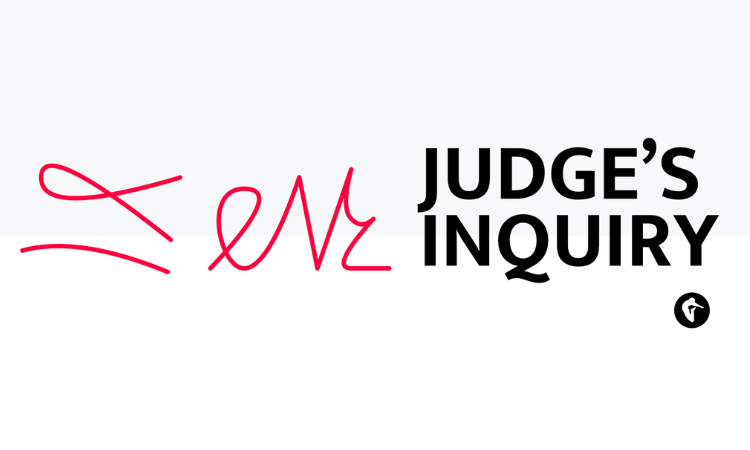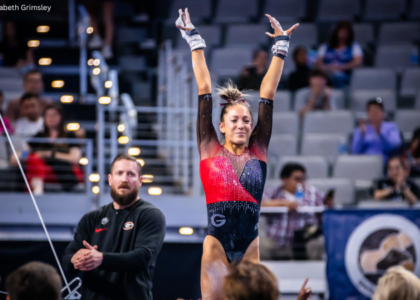While watching some of the week seven beam routines, I saw several connections I wouldn’t have credited but likely were based on most of them scoring above a 9.8. Imagine if judges actually did break these connections. Acro and dance combinations on beam often contribute anywhere from one to four tenths worth of bonus, depending on the series. They also often fulfill a special requirement, which is worth two tenths toward the start value, which cannot be made up with additional bonus. Needless to say, nailing these connections is critical to scoring well on beam, but judges are very hesitant to break them.
A beam series is considered broken if one or more of the following occurs:
- Stop between elements
- Loss of balance
- Deviation of body movement not in line with the beam
- Repositioning of the foot
- Extra step, hop, or jump between elements
- Legs straighten between elements
- Free leg drops and lifts again (cat leaps, hitch kick, beat jump to one foot)
- Trunk stops forward movement (in a forward moving mixed or dance series)
Below are 20 examples of connections just from week seven that I think shouldn’t have been credited. To be fair, I based these judgments on an in-the-moment assessment from the first time I watched the routine, then went back to analyze what exactly broke the connections. At this point in their career, NCAA judges (and I) have judged thousands of beam connections and should be able to expertly make this assessment accurately and consistently.
I reviewed beam routines of the teams that top the beam rankings through week seven and that had video available. Cal, Michigan, and Oklahoma did not have videos available at the time of writing this article, so they are not included. I did include UCLA since watching the Utah-UCLA meet was the inspiration for writing this article. Below are the connections and reasoning using the criteria from above.
No. 2 Utah
- Loss of balance
- Repositioning of foot
- Trunk stops forward movement in mixed or dance series
(I’m guessing the judging panel broke this one as well.)
- Loss of balance
- Repositioning of foot
- Deviation of body movement not in line with the beam
- First connection
- Stop between elements
- Trunk stops forward movement
- Second connection
- Legs straighten between elements
- Stop between elements
- Legs straighten between elements
No. 3 Florida
- Trunk stops forward movement
- Stop between elements
- Free leg drops and lifts again
No. 6 LSU
- Trunk stops forward movement
- Trunk stops forward movement
- Free leg drops and lifts again
- Stop between elements
No. 7 Kentucky
- Stop between elements (her arms keep moving but her trunk stops between elements)
- Loss of balance
- Deviation of body movement not in line with the beam
- Repositioning of foot
- Repositioning of foot
- Repositioning of foot
- Free leg drops and lifts again
- Trunk stops forward movement
No. 8 Auburn
- Repositioning of foot
- First connection
- Stop between elements
- Second connection
- Loss of balance
No. 12 UCLA
- Stop between elements
- Repositioning of foot
- Free leg drops and lifts again
- Trunk stops forward movement in mixed or dance series
- Repositioning of foot
Why were so many of these connections credited? Perhaps judges were afraid of being booed, being harassed by the coaches, or receiving a poor evaluation from the coach that could impact their future judging assignments. Maybe they second guessed themselves when reviewing their notes and calculating the score. Since the consequences can be quite high for breaking a connection, they may not want a star athlete or top-ranked team to lose so many tenths off their start value, especially if the connection was close.
However, by letting these connections slide by, they are inadvertently disadvantaging the athletes that are doing more aggressive connections that may be riskier or result in a fall or balance error. Being slow and careful takes away the difficulty that the code of points awards for connecting a difficult series. Slow connections are not much more difficult than doing the skills in isolation and aren’t worthy of bonus.
These top teams are still scoring consistently high with these broken connections, so why should they make adjustments? If judges started not giving credit, as they should if they were to enforce the rules consistently, teams would need to reconsider their strategies on beam and make some dramatic changes. Beam performance can be the deciding factor in so many competitions since the margin for error is razor thin. More accurate judging could help separate the truly strong beam teams and create more separation among the top teams.
READ THIS NEXT: Judge’s Inquiry: Observations About Judging From the 2024 Season So Far
Article by Rhiannon Franck
Rhiannon Franck is a former national-rated NAWGJ women’s gymnastics judge with over 15 years of USAG judging experience and nine seasons judging NCAA gymnastics. Outside of gymnastics, Franck works at a university as a nursing professor and loves to travel. You can follow her on Instagram and Twitter.





I mean to be fair, if I were a judge I probably would’ve given a few credit. I guess in the moment the eye could confuse those without the really noticeable balance checks. I guess that’s why I’m not a judge.
Would you consider ranking or grading the judging by conference? There seems to be some judging that isn’t consistent during meets. And I would love to see your analysis!